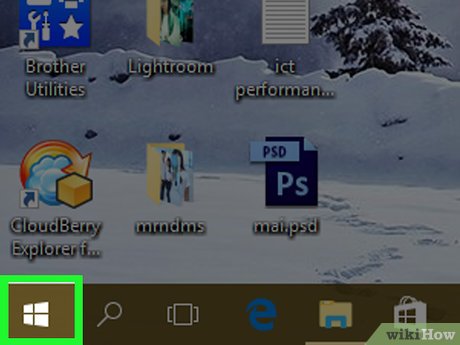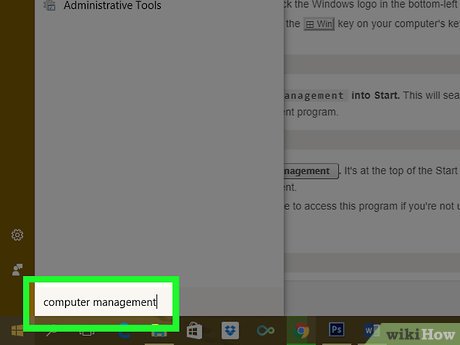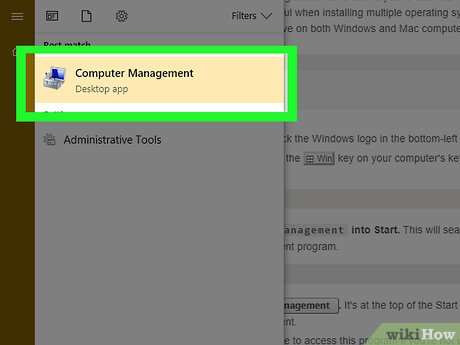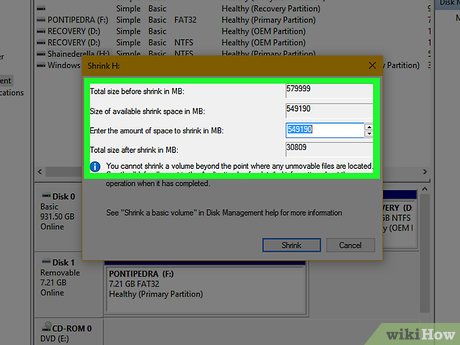How to Create a Partition
Method 1 of 2:
On Windows
-
 Open Start. Click the Windows logo in the bottom-left corner of the screen.
Open Start. Click the Windows logo in the bottom-left corner of the screen.
- You can also press the ⊞ Win key on your computer's keyboard.
-
 Type computer management into Start. This will search your computer for the Computer Management program.
Type computer management into Start. This will search your computer for the Computer Management program. -
 Click Computer Management. It's at the top of the Start window. Doing so opens Computer Management.
Click Computer Management. It's at the top of the Start window. Doing so opens Computer Management.- You may not be able to access this program if you're not using an administrator account.
-
 Click the Disk Management tab. This tab is in the sidebar on the left side of the Computer Management window.
Click the Disk Management tab. This tab is in the sidebar on the left side of the Computer Management window.- If you don't see this option, first double-click Storage.
-
 Select your hard drive. In the window near the bottom of Computer Management, click your hard drive's box. This box should have the hard drive's letter (e.g., "(C:)") as well as the number of gigabytes (GB) of storage available to use.
Select your hard drive. In the window near the bottom of Computer Management, click your hard drive's box. This box should have the hard drive's letter (e.g., "(C:)") as well as the number of gigabytes (GB) of storage available to use. -
 Click Action. It's a tab in the upper-left side of the Computer Management window. Doing so prompts a drop-down menu.
Click Action. It's a tab in the upper-left side of the Computer Management window. Doing so prompts a drop-down menu. -
 Select All Tasks. This option is near the bottom of the drop-down menu. Selecting it prompts a pop-out menu to appear.
Select All Tasks. This option is near the bottom of the drop-down menu. Selecting it prompts a pop-out menu to appear. -
 Click Shrink Volume…. It's in the middle of the pop-out menu. Clicking Shrink Volume... will prompt Windows to determine how much free space you have. When it finishes doing so, a new window will open.
Click Shrink Volume…. It's in the middle of the pop-out menu. Clicking Shrink Volume... will prompt Windows to determine how much free space you have. When it finishes doing so, a new window will open. -
 Determine your partition's size in megabytes. Type the number of megabytes that you would like your partition to be into the "Enter the amount of space to shrink in MB" text field on the right side of the page.
Determine your partition's size in megabytes. Type the number of megabytes that you would like your partition to be into the "Enter the amount of space to shrink in MB" text field on the right side of the page.- The maximum number of megabytes that you can allocate is listed directly above the field that you type in.
- There are 1000 megabytes (MB) in one gigabyte (GB). To create a 5 GB partition, you would type 5000 into the text field.
-
 Click Shrink. It's at the bottom of the page. This will begin creating a segment of your hard drive to serve as the partition.
Click Shrink. It's at the bottom of the page. This will begin creating a segment of your hard drive to serve as the partition.- This process may take a few minutes.
-
 Select the new partition. Click the new partition, which will say "Unallocated", to the right of the hard drive's space.
Select the new partition. Click the new partition, which will say "Unallocated", to the right of the hard drive's space. -
 Click Action again. This tab is in the upper-left side of the window.
Click Action again. This tab is in the upper-left side of the window. -
 Select All Tasks, then click New Simple Volume…. It's near the top of the pop-out window.
Select All Tasks, then click New Simple Volume…. It's near the top of the pop-out window. -
 Click Next. It's in the bottom-right side of the window. This will take you to the beginning of the partition setup.
Click Next. It's in the bottom-right side of the window. This will take you to the beginning of the partition setup. -
 Click Next. Doing so will accept your partition's size and take you to the next page.
Click Next. Doing so will accept your partition's size and take you to the next page. -
 Select a drive letter, then click Next. You can change the partition's drive letter (e.g., "E") by clicking the drop-down box and then clicking a new letter.
Select a drive letter, then click Next. You can change the partition's drive letter (e.g., "E") by clicking the drop-down box and then clicking a new letter.- This is an optional step.
-
 Check the "Format this volume with the following settings" box. It's near the top of the page. This option will set up your partition with Windows default settings, which will allow it to work with Windows like your regular hard drive.[1]
Check the "Format this volume with the following settings" box. It's near the top of the page. This option will set up your partition with Windows default settings, which will allow it to work with Windows like your regular hard drive.[1]- If the "File system" box doesn't say "NTFS", click it and then click NTFS. This will format your partition for Windows.
- You can also change the partition's name in the "Volume label" box.
-
 Click Next. It's at the bottom of the page. This will take you to the final page.
Click Next. It's at the bottom of the page. This will take you to the final page. -
 Click Finish. Doing so will begin partitioning your drive. Once this process completes, you will be able to interact with the partition in the This PC program; it will appear alongside your hard drive in the "Devices and drives" section.
Click Finish. Doing so will begin partitioning your drive. Once this process completes, you will be able to interact with the partition in the This PC program; it will appear alongside your hard drive in the "Devices and drives" section.- Partitioning can take several minutes to several hours, depending on the size of the drive and the partition's size.
Method 2 of 2:
On Mac
-
 Click Go. This tab should be in your Mac's menu bar at the top of the screen.
Click Go. This tab should be in your Mac's menu bar at the top of the screen.- If you don't see Go, click the desktop or open a new Finder window to make it appear.
-
 Click Utilities. It's at the bottom of the Go drop-down menu.
Click Utilities. It's at the bottom of the Go drop-down menu. -
 Double-click Disk Utility. This icon resembles a Mac hard drive with a stethoscope on it. Doing so will open the Disk Utility program.
Double-click Disk Utility. This icon resembles a Mac hard drive with a stethoscope on it. Doing so will open the Disk Utility program. -
 Select your hard drive. Click your Mac's hard drive in the upper-left side of the Disk Utility window, just below the "Internal" heading.
Select your hard drive. Click your Mac's hard drive in the upper-left side of the Disk Utility window, just below the "Internal" heading. -
 Click Partition. This tab is at the top of the Disk Utility window.
Click Partition. This tab is at the top of the Disk Utility window. -
 Click +. It's below the hard drive circle that's on the left side of the page.
Click +. It's below the hard drive circle that's on the left side of the page. -
 Determine your partition's size. Click and drag the knob at the bottom of the hard drive circle counter-clockwise to increase the partition's size, or clockwise to reduce it.
Determine your partition's size. Click and drag the knob at the bottom of the hard drive circle counter-clockwise to increase the partition's size, or clockwise to reduce it.- You can also type a number in gigabytes (GB) into the "Size:" field to set your partition's size.
-
 Select a file format for your partition. Click the File format drop-down box, then click a format. This will set your partition's file system as your selected format.[2]
Select a file format for your partition. Click the File format drop-down box, then click a format. This will set your partition's file system as your selected format.[2]- If you're setting up your partition for use with Mac, click a MacOS Extended option in the drop-down menu.
- You can also enter a name for your partition in the "Name:" field.
-
 Click Apply. It's in the bottom-right corner of the page. Doing so will prompt your Mac to begin creating your partition.
Click Apply. It's in the bottom-right corner of the page. Doing so will prompt your Mac to begin creating your partition.- This process will take a while, especially if your hard drive and partition are both larger than one terabyte.
-
 Click Done when prompted. Your Mac's partition has successfully been created.
Click Done when prompted. Your Mac's partition has successfully been created.
5 ★ | 1 Vote
You should read it
- How to Format a Hard Drive
- Instructions for dividing hard drives right in Windows 10
- Minitool Partition Wizard - Redistribute hard drive with Minitool Partition Wizard
- How to delete a partition on Windows hard drive?
- Advantages and disadvantages of hard drive partitioning
- How to split MS-DOS hard drive (FDISK)?






























 How to Speed Up a Slow Internet Connection
How to Speed Up a Slow Internet Connection How to Make Your Computer Run Faster
How to Make Your Computer Run Faster How to Run Chromebook Chromium OS on a Standard PC
How to Run Chromebook Chromium OS on a Standard PC How to Save Reddit Comments on PC or Mac
How to Save Reddit Comments on PC or Mac How to Delete Preloaded Applications on Android
How to Delete Preloaded Applications on Android How to Change File Names in Bulk on PC or Mac
How to Change File Names in Bulk on PC or Mac